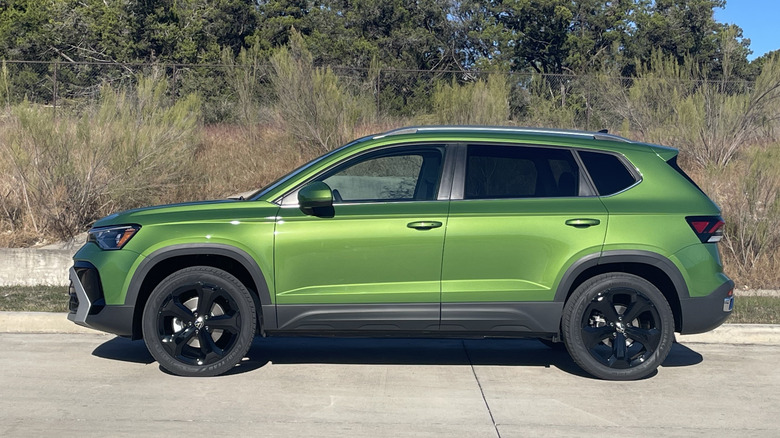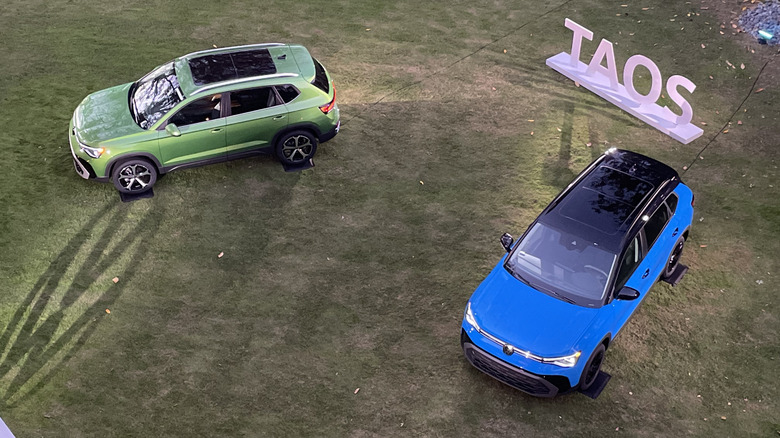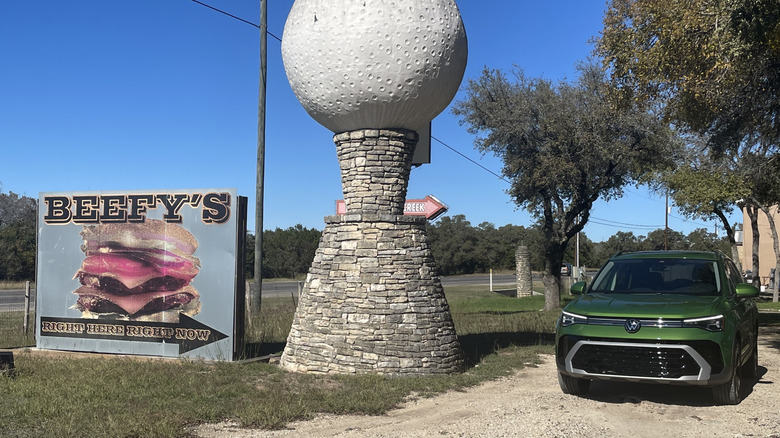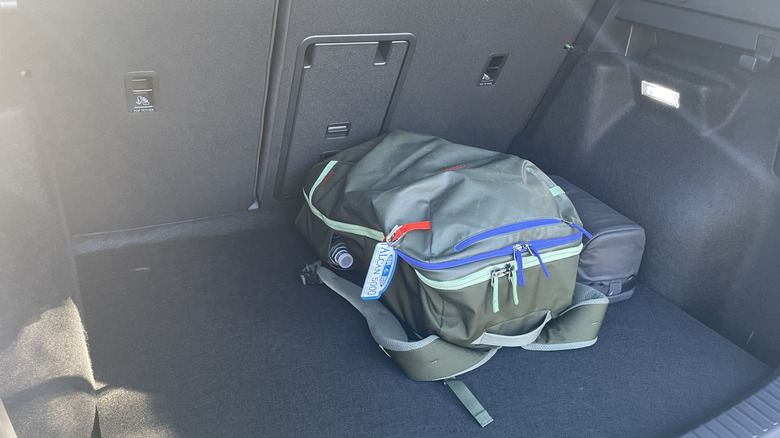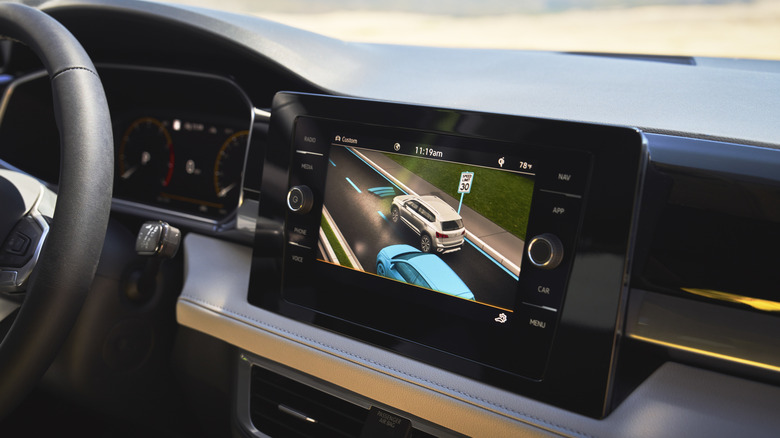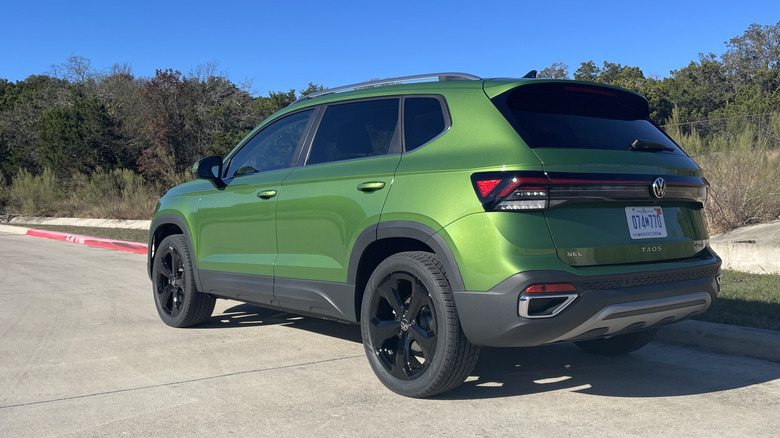2025 Volkswagen Taos First Drive: Size Matters (But So Does Price)
Every time I get in a new Volkswagen, I'm surprised they aren't really bargains anymore. To be fair, VW managed to hold the line, for the most part, on the 2025 Taos refresh, adding new features and some cool styling updates without a significant increase in price. The Taos launched for the 2022 model year, but the segment moves so fast that this refresh was almost overdue.
If there's another area where VW deserves praise for restraint, it's that the company's core SUV lineup — the gas-powered models, at least — is a simple-to-navigate trio, with consistent trim lineups. Mazda offers its crossover in four sizes from CX-30 to CX-90 (and distinct electrified versions, besides); Kia's gasser SUV lineup includes the Niro, Seltos, Sorento, Soul, Sportage, and Telluride. I got decision fatigue just typing all that out.
According to Volkswagen, the Taos sells really well in San Antonio, which is why that other Southwestern city was the setting when the automaker hosted SlashGear for a new Taos test drive. Also according to VW, the Taos is particularly popular with young, upwardly mobile families who don't yet need a third row, and empty nesters who are downsizing, so upgrades and changes were made with these groups in mind.
It's bigger than you expect
Most of Volkswagen's U.S. sales are crossovers and SUVs, which is almost certainly indirectly a contributor to the company's decision to discontinue the manual transmission option across the GTI and Golf R lines. That SUV supremacy reigns to the tune of 76%, the automaker says, and VW sells Taos and Atlas in comparable numbers.
The Taos is classified as a subcompact SUV, and as such, VW identifies its competitors as the likes of the Subaru Crosstrek and Honda HR-V. I had my doubts. The Taos looks much bigger than these vehicles, feels more spacious inside, and handles more like a Subaru Forester than a Crosstrek. I had to check for myself, and I can admit when I'm wrong: the Taos and Crosstrek are within about an inch of each other in terms of length, width, and wheelbase.
VW's generally pretty skilled at designing vehicles that don't feel cramped inside, from the GTI to the Atlas to the new ID.Buzz. Still, it's hard to figure out if it's a net benefit that the Taos feels so airy and spacious inside, or a net negative that from the driver's seat, it seems like a much heftier vehicle than any of its direct rivals. We'll leave that decision up to those first-time parents and the empty-nest Boomers.
2025 brings more power (but still not enough)
The Taos still has a 1.5-liter turbocharged 4-cylinder engine, though its horsepower has been upgraded from 158 hp to 175 hp. Torque stays the same at 184 lb-ft., but a little more would make a huge difference.
Volkswagen claims customer feedback prompted a switch from the brand's dual-clutch automatic transmission to a standard 8-speed automatic, though only in the all-wheel drive models. This is supposed to provide a more traditional shifting experience, but the best transmission in the world would struggle if the engine simply wasn't capable of doing its job.
Frankly, even with the 2025 increase, the Taos still doesn't have enough power. If the new transmission actually makes a difference compared to the 2024 model, it's so incremental as to be almost unnoticeable from behind the wheel. This is largely why I was convinced that the Taos is much bigger than it is, that visceral experience of a vehicle's engine struggling to comply. It's by far the Taos' biggest drawback.
It's heavy, and ponderous
Though the engine is fine upon achieving cruising speed, getting there is a chore. Our test drive through the countryside surrounding San Antonio was littered with stretches of the kinds of 65 mph divided roads that nevertheless have semi-frequent stoplights. My drive partner and I were chatting about regional dialect, and she mentioned she was surprised to learn as an adult that most of the country does not call traffic lights "stop-and-go lights."
This is relevant, or at least faintly amusing to me, because every time we stopped at a red, I almost dreaded the seconds that would tick by as the Taos decided to comply with the "go" part upon the light changing. And, because we were in Texas, this inevitably occurred with an angry-looking lifted pickup bearing down in the rearview mirror. That said, taking off from a stop at city speeds is just fine. Not especially fun or interesting, but fine.
The handful of drive modes do help matters somewhat. I didn't notice much difference between Eco and Normal modes, but Normal to Sport is a big upgrade in terms of throttle and steering tuning. We unfortunately didn't get to test the more complex Off-Road mode; we fortunately didn't have to test Snow mode. While these modes are all standard with AWD Taos configurations, the Off-Road and Snow modes live in the infotainment system while the regular modes, in theory, are controlled by a dial near the shifter. In reality, that triggered a touchscreen prompt that wasn't particularly intuitive. There's also a Custom mode that can save individual throttle, suspension, and steering preferences.
It's loud
The Taos is really loud. And miraculously, it's not because of the overtaxed engine, though that would be a reasonable assumption.
One of the first things I noticed about this VW, as I was tossing my stuff in the backseat to prep for our drive, is that the doors open and close loudly. I know soft-close doors are still generally a luxury or luxury-adjacent touch, but this was excessive.
From the cabin, wind noise is overwhelming, as if we were being buffeted in all directions, or constantly driving mountain passes. Neither of those scenarios were the case; in fact, we were discussing potential reasons for the noise as we passed an industrial park decorated with a ton of tall flagpoles with flags that weren't moving at all. There's very little road noise on smooth roads, but any pavement texture whatsoever adds its own two cents to the conversation.
A little more insulation against sound and vibration would go a long way toward helping this VW feel more premium.
Plenty of space and toys inside
The updated cabin has a fresh look and feel, greatly aided by the massive panoramic glass roof that spans both rows, and distinct colors and materials for each trim level. Our SEL test model featured leather upholstery, heated front seats, and class-exclusive ventilated front seats. Upholstery materials felt nice and the seats were comfortable.
A new dashboard design offers a good view out the front window, and a low belt line lets in plenty of light. The 8-inch touchscreen display is standard across the lineup, landscape-oriented and perched on a ledge above the center console. It's not the most elegant screen integration we've seen, but looks much classier than some of its rivals. It could be overwhelming, paired with the upgraded 10.25-inch customizable Digital Cockpit instrument display (an 8-inch version comes standard on base and mid trims), but the otherwise welcoming feel helps keep it from feeling too tech-forward. Other standard comfort features include heated front seats on all but the front-wheel drive base model, and a heated steering wheel.
Another new feature is a driver alert system that can send warnings and notifications — for example, letting other traffic know you're stopped on the side of the road — to nearby drivers using systems like Waze.
It's a bit too shiny
VW's team was eager to point out that the Taos now features more soft-touch materials throughout the cabin: the example cited was that the old door panels, molded of hard plastic, have been swapped out in favor of upholstered panels. That's a nice touch, of course, but there are other missteps. Namely, the scourge of the entire automotive industry — piano black plastic trim.
Our SEL test model, top tier and not at all a value play, had a big swath of this wretched material spanning the dashboard, and even worse, it was joined by a swath of a semi-matte silver plastic. This combination cheapened the entire look and feel of the cabin, and for what? Touch that plastic once, perhaps to wipe off some dust, and your fingerprints will be there forever, practically burnished into the surface.
Furthermore, several times while driving, the sunlight streaming in through the passenger-side window reflected off an angle in the plastic, casting a glare so bright it could have started a fire or perhaps sent a commercial airliner tumbling to the ground. Fortunately, we weren't going that fast.
The Taos' competition is fierce
This pretty crossover ain't cheap. Yes, VW managed to provide some substantial updates while keeping the price stable from 2024 to 2025, a commendable feat. But still.
On sale now, the base 2025 Taos S starts at $24,995 with front-wheel drive, and $26,695 with all-wheel drive. There's the SE ($27,895/$29,595) and SE Black ($30,145/$31,845) which are arguably the best values with upgraded tech, wireless charging, better upholstery, parking sensors, and, for the Black, styling upgrades and that big sunroof. The $34,695 SEL, our test car, gets leather upholstery, sophisticated 19-inch wheels, and ventilated front seats, among its upgrades. VW says about 55 percent of Taos buyers go for AWD, and the value-oriented SE trim is generally the most popular.
Compare that to the Subaru Crosstrek, which comes standard with AWD and starts at $25,695. Its base trim is underpowered, too, but all other trims are rated for 182 hp and the top-spec Wilderness is $32,495. The Honda HR-V also starts a little more expensive than the Taos, at $25,100 with front-wheel drive, but its top trim with all-wheel drive is just $30,700. VW also cites the Mazda CX-30 and Toyota Corolla Cross as key competitors, but there are so many vehicles in this segment that it would be near-impossible to compare them all.
Notably, the 2025 Taos is built in Mexico. VW says it will deal with the incoming White House administration's tariff issue if and when it comes to fruition.
2025 Volkswagen Taos Verdict
Even with that somewhat nebulous threat dangling, VW's little crossover has its share of hits and misses. The Taos' visual updates are nice but mostly on the subtle side. The signature daytime running lights and projector headlights now come standard across the lineup, and the new bar of brake lighting across the hatch helps set off an illuminated rear logo. Illuminated badges are tricky to pull off, but VW's is a success, better executed than that found on another German brand: it looks classy rather than tacky. It nicely mirrors the newly available light bar that runs across the front grille, which gives the Taos an EV-like look, like VW's ID.4 electric crossover.
The overall experience is an odd mix of upscale and downscale. The exterior is truly lovely; I don't think the changes are all that different from the previous model year, but it's a cohesive look, and works well with the brighter colors in VW's palette. Yet, the doors slam loudly. The hatch, even in top SEL trim, has a grab handle rather than a power-close button, and the front passenger gets a manually adjustable seat with a weird loop-shaped handle. The central display told us a few times that the speed limit was 90 mph... wishful thinking, Taos, not least given the underpowered engine.
In short, the 2025 Taos' appeal depends where your own priorities lie: it hits the mark on style and creature comforts, but even remotely keen drivers will want to take their budget elsewhere.
